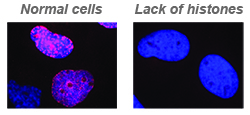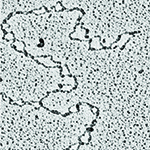Proteins essential for DNA copying identified
In every one of our microscopic cells lies two meter DNA precisely rapped around specialized histone-proteins. Together, DNA and histones form a structure called chromatin. In the last decade, it has become increasingly clear that cell identity and behavior is not only determined by our DNA code, but also dependent on information stored in the chromatin structure. New research from BRIC, University of Copenhagen show that chromatin formation and DNA copying are coupled processes during cell division. If cells are short of histones, chromatin formation stops and blocks continued DNA copying. The research has just been published in Journal of Cell biology
Results confirm prevalent theory
A link between DNA copying and availability of histones was already proposed in the 70’ies, but has been impossible to verify. The researchers at BRIC have used a new and advanced microscopy technique that makes it possible to examine individual DNA molecules. With this technique they observed a clear link between histone availability and DNA copying.

In normal cells, DNA undergoing duplication (pink) are seen in the cell nucleus (blue). In cells deprived of histones, DNA copying is significantly repressed. Photos: Yunpeng Feng, BRIC.
“If we deprive cells of histone building blocks DNA copying initiate normally, but when cells run out of histones to wrap the new DNA around, copying pauses. The pause is used to produce new histones, so that chromatin formation and DNA copying can continue. However, if histones shortage persists, damage to the DNA can occur because copying cannot be completed, explains postdoc Yunpeng Feng, who has lead the experiments.
Histone shortage can result in disease
Recently, Anja Groth’s team has shown that altered availability of histones is contributing to the developmental disease CDAI anemia. Patients with CDAI have a gene defect that the researchers showed affects delivery of newly synthesized histones into the cell nucleus, where DNA copying takes place. The result is that the patients develops anemia, as they cannot form the thousands of new blood cells needed every day.

Single DNA fiber studied with the new microscope technique in the Groth research group. Photo: Kai J. Neelsen and Massimo Lopes, Institute of Molecular Cancer Research, University of Zurich
However, histone supply and chromatin formation are also crucial for development of cancer, affecting almost one third of the adult western population.
"Our research clearly shows that formation of chromatin is orchestrating DNA copying during cell division - If chromatin formation is disturbed, a safeguard mechanism kicks in and pause DNA copying. This is crucial to stabilize our genes and prevent that defects in the chromatin structure are passed onto the daughter cells. As such defects are potentially cancerous, coupling of chromatin formation to DNA duplication in both time and space is absolutely essential for our organism", says associate professor Anja Groth leading the research team behind the findings.
The next step for the researchers is to find out whether the safeguard mechanism they have identified pausing DNA copying, is part of our cells defense system against cancer.
The work has been supported by research grants from the Danish Cancer Society and the Lundbeck Foundation.
Topics
Related News
Contact
Original paper
Mejlvang J, Feng Y, Alabert C, Neelsen KJ, Jasencakova Z, Zhao X, Lees M, Sandelin A, Pasero P, Lopes M, Groth A. New histone supply regulates replication fork speed and PCNA unloading. J Cell Biol. 2014 Jan 6;204(1):29-43.
